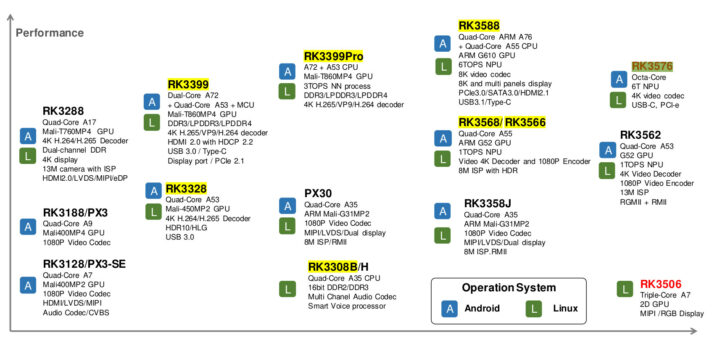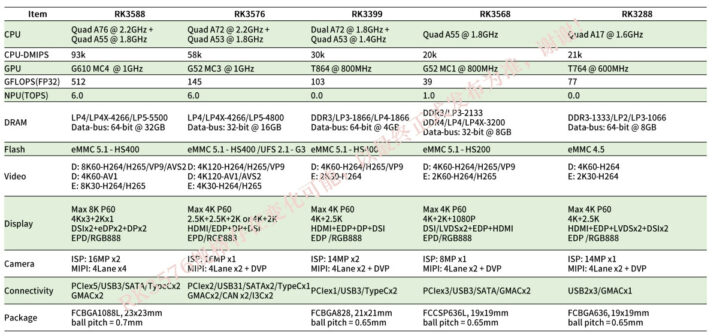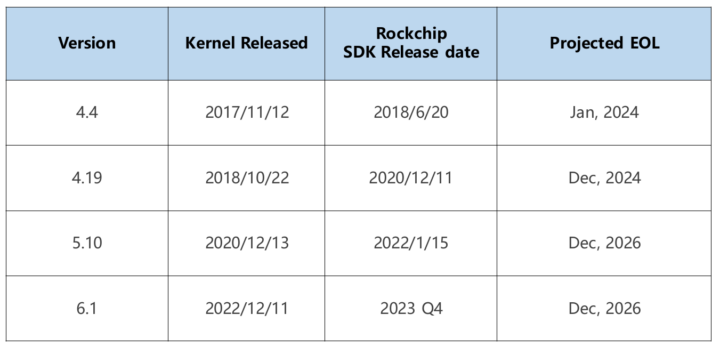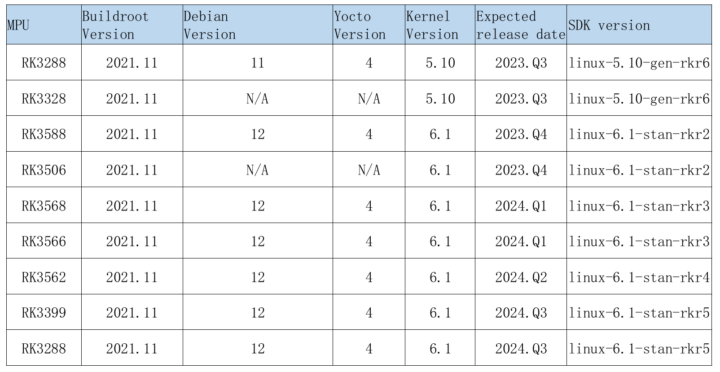The Rockchip RK3588 processor may remain the most powerful processor from the company for a while as an updated Rockchip IoT processor roadmap reveals the new RK3576 octa-core SoC and RK3506 tri-core Cortex-A7 chip, as well as a Linux 6.1 SDK to be released in Q4 2023.
With the limited information we have, the Rockchip RK3576 looks to be a cost-down version of the RK3588 processor with eight cores, a 6 TOPS NPU, a 4K video codec, as well as PCIe and USB-C interfaces. Strangely the Rockchip RK3582 that should serve a similar purpose is not showing up in the roadmap. [Update: The RK3576 is indeed a lower-cost SoC but features four Cortex-A72 and four Cortex-A53 cores instead as per the comparison table reproduced below:
That also means we now have the RK3576 specifications (some obtained from another document too):
- CPU
- Octa-core Arm processor with 4x Cortex-A72 cores at 2.2 GHz, 4x Cortex-A53 cores at 1.8 GHz
- Arm Cortex-M0 MCU at 400MHz for user
- GPU – Arm Mali-G52 MC3 GPU
- VPU
- 4Kp120 H.265, H.264, AV1, VP9, AVS2 video decoder –
- 4Kp30 H.264/H.265 video encoder
- 4Kp30 MPEG encoder and decoder
- Supports for 4Kp120 + 2.5Kp60 + 1080p60
- NPU – 6 TOPS NPU with INT4/8/16/FP16/BF16/TF32
- Memory – 32-bit LPDDR4/LPDDR4x/LPDDR5
- Storage
- UFS 2.1 w/ HS-G3 (12Gbps)
- FSPI (Octa), eMMC 5.1, SDMMC 3.0
- Video Output
- HDMI 2.1 up to 4Kp120 or eDP 1.3 up to 4Kp60 Combo Tx
- MIPI DSI-2 up to 4K60
- DisplayPort 1.4 up to 4Kp120
- ePD (Electronic Paper Display) up to 2560×1920
- Parallel interface (RGB888) up to 1080p60
- Camera I/F
- 2x MIPI CSI-2 with D-PHY (4×1, 2×2)
- 1x MIPI CSI-2 with C/D-PHY (4×1)
- 1x 8/10/12/16-bit DVP
- Picture Quality – Deinterlace, De-noise, Zoom Manage Engine, Sharpness, Edge Smoothing, DCI-HIST, 3D-LUT, ACM, HDR
- Audio
- I2S/TDM/PCM (2x 4T4R, 3x 2T2R)
- 2x 8CH PDM
- 2x S/PDIF
- ASRC (2x 2CH + 2x 4CH)
- Networking – 2x RGMII interface, i.e. dual gigabit Ethernet
- USB – 1x USB 3.2 Gen 1 with support for Type-C Alt Mode with DisplayPort
- PCIe
- 1x PCIe 2.1/SATA 3.1/USB 3.2 Gen1 combo port
- 1x PCIe 2.1/SATA 3.1 combo port
- Other I/Os – CAN FD, I2C, SPI, UART, GPIO
- Security
- Arm TrustZone security extension
- Secure boot / key ladder / OTP
- Cipher engine (RSA, ECC, HASH, DES, AES, SHA, SM)
- Package – 16x17mm, 0.65pitch, FCCSP package

Engineering samples are expected in 2023Q4. Rockchip expects RK3576 to be found in tablets, AIoT applications, e-Ink displays, Arm PCs, and automotive applications.]
The Rockchip RK3506 will target cost-sensitive Linux IoT/HMI applications with a triple-core Cortex-A7 CPU, a 2D GPU, and MIPI and RGB display interfaces. I could not find additional public information for either RK3506 or RK3576 at this stage, and all information comes from the slides used in a September 2023 presentation with OKDO, RS components, Radxa, and Rockchip themselves.
That document also includes a kernel and SDK roadmap with Rockchip planning to release Linux 6.1 SDKs/BSPs with Debian 12 between Q4 2023 and Q3 2024 for the RK3588, RK3506 (no Debian), RK3568, RK3566, RK3562, RK3399, and RK3288 with the exact expected schedule for each SoC shown in the table below.
All targets will be supported through the Buildroot 2021.11 build system, and apart from the low-end RK3506, all targets that will get a Linux 6.1 SDK update will be supported through the Yocto 4.0 build system as well. Rockchip is supposed to keep us up-to-date on its open-source website but the pages related to the Linux kernel and the software matrix have not been updated since 2019-2020. The GitHub repo for the Rockchip Linux kernel is not getting a lot of love either with the last commit dated September 30, 2022 (Linux 5.10 branch).
Thanks to Geoffrey for the tip.

Jean-Luc started CNX Software in 2010 as a part-time endeavor, before quitting his job as a software engineering manager, and starting to write daily news, and reviews full time later in 2011.
Support CNX Software! Donate via cryptocurrencies, become a Patron on Patreon, or purchase goods on Amazon or Aliexpress








